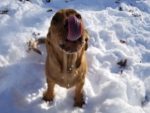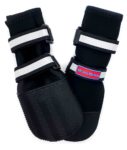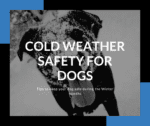
If you live in an area that has cold and snowy winters, those months can be very dangerous for a canine companion. It is the best practice to be cautious when your dog is outside during those cold days. These cold weather safety tips can help any dog owner be prepared!

Outside Time When It is Cold Out
Walks
Your dog may be used to being walked three times a day for 10 minutes a walk. In the winter months, this could potentially be very dangerous, for many reasons. Dogs do have a fur coat and nice padded feet but those do not mean that they are completely cold weather resistant. The rule of thumb for cold weather safety is if it is too cold for you, it is too cold for your dog.
During the winter months, check the temperature before leaving the house. If it is too cold or there is a large wind chill, skip the walk for that day. You can exercise your dog indoors in other ways. Check out Exercising Your Dog’s Mind to see ways of relieving boredom when indoors.
Another thing to be mindful of is salt on the roads. Usually the companies that plow and salt the roads do not use pet safe products. The salt on the roads can be filled with toxins, like antifreeze. Dogs should not be eating salt, snow, or slush on the roads.
Potty Breaks
During the winter months, your dog is going to need to go outside to relieve themselves at some point. If the weather is frightful, potty breaks need to be as short as possible. Have your dog on a leash so you can encourage them to return into the house if they have been out too long. This also helps with the dramatic dog who refuses to walk in snow. If they are taking too long and not going to the bathroom, return inside and crate them until they warm up then try again.
Car Rides
Your dog should never be left unattended in a vehicle when there is severe weather, hot or cold. During winter time, leaving a dog in a car can result in possible injury due to the temperatures. Even if you think you are going to be quick, take your dog home first then go shopping.

Possible Cold Weather Injuries
Dry Skin
After the heat kicks on, the air inside a home becomes dry and that dry air can cause a dog’s skin to dry out. Especially after coming inside from the wet cold environment. The skin becomes dry, flakey, and itchy. To avoid this, wipe your dog off completely after coming inside from being in the snow. Focus mostly on the feet so the pads don’t dry out and crack. It can also be beneficial to run a humidifier during the winter months.
Hypothermia
Hypothermia is when the dog’s body temperature is lowered to extremely low levels. This occurs by being in a cold environment for too long or having wet cold fur in windy environments. When a dog enters into a hypothermic state their body temperature drops, heart rate drops, and their breathing becomes slow.
If a dog is in severe hypothermic shock, they need to be seen by a Veterinarian immediately. For mild hypothermia, the dog needs to be placed in a warm dry area and they need to be wrapped in dry blankets. This should be done with any dog that is reading 90-94 degrees Fahrenheit. It is best practice to have the dog seen by a Veterinarian for either situation.
Frostbite
Frostbite is damage to the skin caused by extreme cold temperatures over a prolonged period of time. If the outside temperature is below 32 degree Fahrenheit, the blood vessels contract which restricts blood flow. This causes tissue damage. Signs of frostbite are discoloration in the skin, coldness to the touch, pain when touched, swelling, blisters, or blackened skin. If any of these signs are seen, contact a Veterinarian immediately.
Being Proactive With Cold Weather Safety
Grooming
Dogs should be kept as dry as possible during winter months. If they are left wet it can lead to dry and cracked skin or hypothermia. When your dog comes in from outside, take a dry towel and wipe them down thoroughly. Wipe the paws down, getting in between each pad. For those dogs with long coats, make sure there are no clumps of snow left behind in the fur.
Never ever shave your dog during the winter months. Removing their fur makes them more exposed to the winter chills. For those dogs with thick coats, this removes the undercoat, which keeps them warm the most.
Weather Attire
There are many different items that can be purchased to help a dog cope with the cold weather.
Boots
If your dog is a lover of walks and you know it will break his heart to skip one, booties would be the best accessory. Having a dog wear winter shoes while walking helps protect their feet from frostbite, salt, and slipping!

Coat
For those pups with shorter fur, a coat is a great thing to wear when outside. There are many different thicknesses and styles. Having extra layers around the center of the body will keep your dog warm for a lot longer when outdoors.

Preparedness Plan

It is pretty scary to think about, but sometimes winter storms bring the worst. There may be a situation where you may be in your home for an extended period of time or delivery people cannot get to you. To be proactive about this, make sure during the winter months that you have extra food, bottle water, and extra medications. This way if anything occurs, you and your pup are ready. For more information on emergency planning, check out Ready.gov. This could possibly be the best winter weather safety tip!
